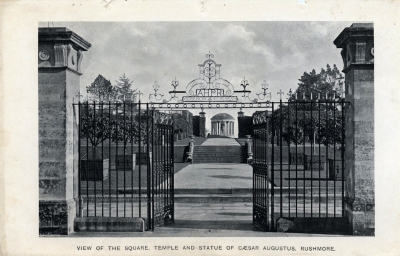To search the RPR site click here
Progress Report 6: April - end August 2012
This is the final progress report of the Rethinking Pitt-Rivers project.
This progress report records activity during this six month period of the Rethinking Pitt-Rivers project.
Much of the final six months has been spent writing the monograph which is (one of) the major outcomes of the project. A first draft was completed in April 2012 but now the serious work began, discussing, re-arranging, re-wording, editing, researching and revising. A date for the publication of this monograph has not yet been set, but information will be added to the website as this becomes clearer.
Jeremy continued his year of working on the Rethinking Pitt-Rivers project 'full-time'. He had written a successful application to the University's Fell Fund for a new research project, involving the researcher and himself, to run from September 2012 for one year. This project will look at the early years of museum anthropology at Oxford, particularly concentrating on the archival holdings of the University for Acland, Rolleston and Tylor among others. Jeremy was also supposed to be considering and revising the several outputs drafted by Alison during the last six months.
Sue Johnson's second exhibition of works related to Cambridge University Library's catalogue of Pitt-Rivers' second collection continued until June 2012. After the exhibition closed it was still possible to purchase copies of Sue's images, see here.
The project was exceedingly lucky to get more new volunteers / interns to work with the project: Christa Gray, and Farah Qureshi who worked on transcribing the library catalogue (this work will be completed by the end of 2012). Peter Rivière continued to do interesting research which was disseminated via the website.
On 21 April 2012, Alison Petch gave a 'spotlight' talk in the Museum to visitors on London, Oxford, Farnham: the collections of Pitt-Rivers. A week later she led a question and answer session for the Education guides of the Museum on Pitt-Rivers collection and the early history of the Pitt Rivers Museum.
At the end of May 2012 Alison Petch led a group of Pitt Rivers Museum Friends, including many of the students from the M.St course at the museum and other members of the Rethinking Pitt-Rivers project team, on a visit to many of the places associated with Pitt-Rivers including Sandroyd School (better known to us as Rushmore), Larmer Tree Gardens and a visit to the exterior of Farnham Museum. The group also visited the Pitt-Rivers' displays at Salisbury and South Wiltshire Museum, kindly hosted by Adrian Green and toured its current exhibition, appositely about Cranborne Chase (and well worth the visit on its own). Two weeks later Rachel McGoff and Alison Petch returned to the area to visit Pitt-Rivers' memorial at Tollard Royal and take some photographs which are available on this site.
Between August and October 2012 a new temporary display of objects related to one of Pitt-Rivers' most famous set of objects - the set of paddles that he used to show the evolution of design in Evolution of Culture - was shown in the Lower Gallery of the Pitt Rivers Museum. The exhibition was organized by Jeremy Coote and the exhibition labels were prepared by Alison and Jeremy. The displays were designed by Alan Cooke and Chris Wilkinson, Pitt Rivers Museum technicians.
There was a display of newly acquired manuscript and photographic collections illustrating Pitt-Rivers' life and work between his childhood and his death in 1900 in the Archives case on the Lower Gallery entrance area adjacent to the lift in the main Museum from 10 September 2012 until January 2013. The display was designed by Adrian Vizor, another PRM technician, and co-curated by Jeremy and Chris Morton, Curator of Photographic and Manuscript Collections.
The project website continued to attract new visitors. There was a new monthly record for RPR website visitors of 5,000 in July 2012, almost double that at the same month in 2011 and beating the previous monthly record (set in February 2012) by 11%. More than 60,000 visitors have visited the website since figures began to be kept (November 2009). It is hoped that the number of figures will continue to rise after the project has been completed, especially once the database interface was changed (during August 2012). After that each of the objects from the founding and second collection listed there will generate specific google-searchable urls / webpages meaning that searches on specific objects / types of objects anywhere in the world will find objects from these collections in the search results. It is hoped this will greatly increase footfall to the site. We have had consistently good (unsolicited) feedback from users about the site though no specific feedback has been actively sought. Judging by the correspondence that all research team members have received, generated by the content of the website, the placing of raw data onto a website is a very effective way of reaching fellow scholars with useful information to share.
Alison spent the final weeks of the project tweaking and enhancing the project website. Although new contributions from the team and other researchers continued to be received throughout the period in question (and will continue to do so after the end of the project, to a lesser extent) all new data will continue to be added to the website so that the website can continue to be a vibrant and changing reflection of scholarship about Pitt-Rivers, his life and work.
AP April - August 2012




